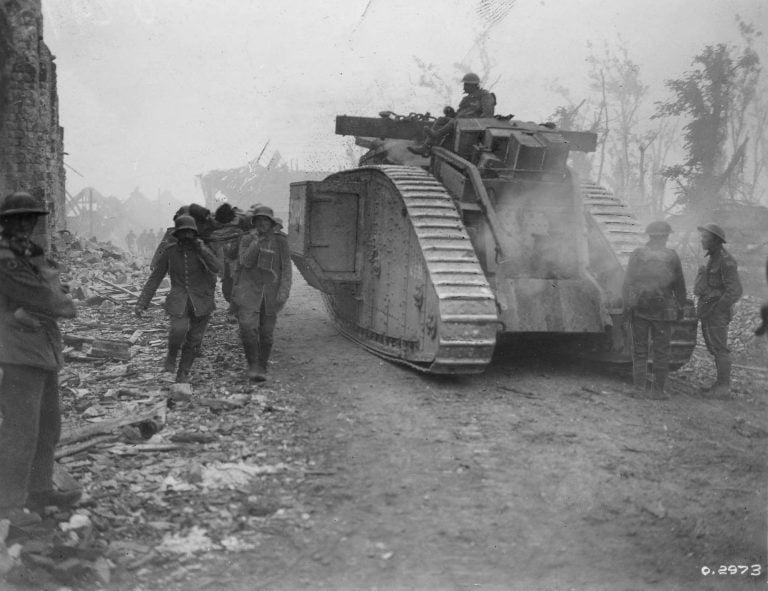On this day 100 years ago, Canadian troops led the First World War’s final charge
The last hundred days of the First World War started on Aug. 8, 1918. One hundred years later, J.L. Granatstein chronicles those arduous final battles.

World War I – Artillery. Verso of photograph reads: Tanks advancing up the Amiens-Roye Rd. August 1918. Caption: Amid the heat and dust of Amiens – Tanks advancing up the Amiens-Roye Rd. on August 8, 1918, when the Canadians advanced six miles. So fast was this great surprise attack, planned by Foch himself, that the tanks had a hard time keeping up. But the effect of one of these monsters coming slowlyand purposefully across the fields was enough to make the bravest man quake. They spat machine-gun fire, trod down barb wire and pushed over walls, never pausing in their strange turtle-like advance. (Royal Canadian Air Force)
Share
The First World War concluded on Nov. 11, 1918. In commemoration of its 100th anniversary, Maclean’s asked renowned historian J.L. Granatstein to tell the story of Canada’s renowned final push to the end of the war, known as the Hundred Days. Read those dispatches here.
“Every gun shot together,” wrote Gunner Bertie Cox, “and the thing was off. I never heard anything like it in my life … We fired our first shot at 4:20 a.m. at 800 yards and in three hours, the enemy was out of our range (6,500 yards).”
It was the first of Canada’s Hundred Days that ended the Great War. The attack at Amiens, France, set the Allies on the road to victory, and the Canadian Corps, led by Lt.-Gen. Sir Arthur Currie, was in the vanguard.
The Canadians had established a record as “shock troops” at Vimy Ridge, Hill 70 and Passchendaele and, whenever the Germans knew Currie was going to attack, they prepared for the worst. Getting the Corps to Amiens had to be accomplished in secret, and this was no simple task. From their positions near Arras, 65 km to the north, the 100,000 Canadians and all their equipment, trucks, guns, horses, food and ammunition had to be moved quietly at night by road, rail and on foot. Soldiers were ordered, “Keep your mouth shut!” Disinformation tactics were aimed to persuade the Germans that the Canadians would attack on the Arras front. The staff officers planning the Amiens attack had to draft their orders in a hurry.
READ MORE: The lifespan of a Canadian First World War pilot was ten weeks
Flanked by Australian and French formations, the Canadians went into action in the early morning, the infantry, accompanied by tanks, following the heavy artillery barrage closely, keeping pace as the gunfire moved ahead in one-kilometre increments.
The tanks, “creeping down the slope like huge great beetles,” as Padre F.G. Scott wrote, played a critical role, shooting up German machine-gun posts. “Fortunately for us, “ Lance Cpl. Ken Foster of the 2nd Battalion said, “the tanks soon put them out of action, provided of course, that an anti-tank shell did not get them first. Without the tanks, I’m afraid it would have been a hopeless task.”
The Germans, stunned by the artillery barrage and the tanks, initially offered little resistance as the infantry advanced. Maj. Ian Sinclair of the 13th Battalion wrote that his unit cleared a wood but then faced heavy fire from a trench where “a large party of Huns held out, using rifle grenades and bombs effectively.” Two Canadian mortars “assisted in quickly reducing the garrison, who put up white flags.” By noon, John Scratcherd, a young artillery officer said, “it had developed into the kind of war that I have always dreamt about. Open country with no trenches or barbed wire, and no artillery fire; cavalry dashing all over the place rounding up the parties of Hun and armoured cars rushing about.”
RELATED: The forgotten Chinese labourers of the First World War
For the Allied soldiers who had fought the war in the trenches, open warfare really must have seemed like a dream. The hard slogging for small patches of shell-torn ground won at a very high cost had been replaced by rapid advances and combined arms warfare—infantry, artillery, armour, engineers rapidly bridging streams, good communications and the Royal Air Force overhead strafing enemy positions.
Open warfare did not mean fewer casualties—fighting in the face of machine guns inevitably took a heavy toll—but at least there were genuine gains. So much so that Gen. Erich Ludendorff, the Germans’ chief strategist, called Aug. 8 “the black day.” The Germans had launched huge attacks against the Allies between March and June, but now, after Amiens, there was no longer hope of resuming the offensive. The enemy now knew the war must be terminated.
Not yet, however. The Canadians continued the attack for the next several days, but German reinforcements of men and aircraft had been poured in, the Allied supply chain began to break down, and the costs for every metre of ground increased. Currie and the Australian Corps’ Sir John Monash urged the British Expeditionary Force commander, Field Marshal Sir Douglas Haig, to halt the advance. Haig agreed, telling Currie that Amiens was “the finest operation of the war.” The Canadian Corps soon returned to the Arras front to recuperate and ready for the next assault.
The attack at Amiens had been an extraordinary success, the Canadians going forward 13 km on the first day and gaining an additional 10 km before the attack came to a halt. But the toll had been heavy: 11,822 officers and men killed, wounded or taken prisoner. There were no easy victories in the First World War.
J.L. Granatstein is a historian and former Director and CEO of the Canadian War Museum.